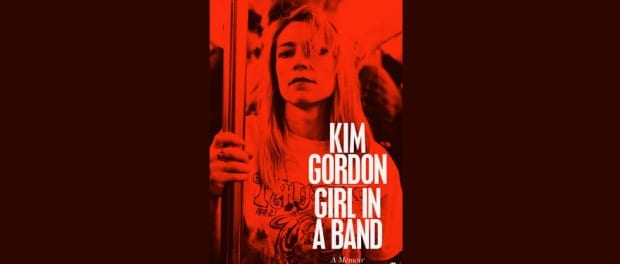From 1981 Kim Gordon was part of the American rock group Sonic Youth, being the guitarist, bassist and occasional vocalist. Before Sonic Youth’s formation, Gordon dated Thurston Moore, whom she eventually founded the band with. The pair was married for 30 years before separating in 2011, coinciding with the band ending. Albeit perhaps being known most prominently for her work within the band, Gordon is also an artist, a designer, a producer and writer. Gordon’s memoir Girl In A Band follows her through all her occupations, and Gordon claims herself she didn’t know what she was doing; making it up as she went along, there was no plan for the iconic, pin-up indie rock chick. The memoir adopts a circular narrative. with the first chapter documenting Sonic Youth’s last ever show, fittingly entitled ‘The End’.
Gordon explains that the last few years of her and Moore’s relationship was fragmented, Gordon giving Moore multiple second chances after his repeated adultery and each time falling short. When they did decide to separate, there was prolongation of the announcement in order to tell their daughter Coco before news sites got hold of it, and to maintain a sense of normality during Sonic Youth’s last few shows. Gordon claims she was “exhausted and watchful’’ throughout the band’s last show, making sure there was a large distance put in place between her and Moore; 30 years in a committed relationship then having your partner cheat on you does that to you. Their end and the way it seemed to come about shattered and contradicted to the cool indie image so many associated them with; it occurred by badly hidden text messages and smutty videos. Perhaps this is the reason why the memoir has sold so well, because people want to know the truth: people are fascinated by the ending of such a seemingly unbreakable and idolised couple. After Gordon brushes over this event at the start of the book she soon delves into her past and growing up.
Many people have made a point of labeling Gordon as stoic and icy in her demeanor; she says people know her as “Opaque or mysterious or enigmatic or even cold,” but in fact she describes herself as “shy and sensitive,” which this memoir does reveal. From going into the repeated questions she gets asked about how she juggles both being a mother and a rock star and how she feels like people only believe you can be one or the other, to her fascination of art which she continues well into Sonic Youth, her artistic presence being prominent in the band’s album covers; Gerhard Richter’s painting on 1989’s ‘Daydream Nation’ and Raymond Pettibon’s image for 1990’s ‘Goo’ album. It all reveals a side of Gordon that many people were naive to and hence now interested in.
Gordon references formative years in Hawaii and Hong Kong and talks of growing up in LA alongside an infatuation with Joni Mitchell’s music. She also reveals the influence her elder brother Keller – “brilliant, manipulative and sadistic,” also schizophrenic – had on her and how his effect on her has continued even up to now. The havoc he wrecked on her life highlighted Gordon’s hypersensitivity and how exactly to hide it, influencing her seemingly apathetic disposition. ‘Schizophrenia’, sung by Moore, touched on her and Keller’s relationship.
Feminism also heralds a prominent presence in the memoir. Throughout her life Gordon has lived in a male dominant world, and she talks of the intrigue this led her to, provoking her to want to be in a band. Gordon was one of the inspirations behind the Riot Grrrl movement; her claim that “the girl anchors the stage, sucks in the male gaze, and throws it back at the audience” epitomises the feeling behind the movement. Gordon channelled this idea of strong females in a lot of her work, including her clothing range X – Girl. In the 90s, Gordon’s lyrics became feminist mantras, challenging things like women in the cooperate world. In the memoir Gordon bashes Lana Del Rey, claiming she “doesn’t even know what feminism is”, and she does have a point; arguably singing and romantising domestic abuse towards women at the hands of men isn’t really propounding the idea of women being free and not subservient to men. In the late 90s one of Gordon’s projects was Free Kitten, a strong female punk band with former Pussy Galore artist Julia Cafritz who made fierce feminist statements.
Gordon has made a point in not being defined by the breakup, of both her and Moore and Sonic Youth. First and foremost, Gordon was a conceptual artist, her first job being in an art gallery and art being the reason for her ending up in a band. Her education orientated around art, attending two different art schools with artists like Dan Graham influencing her, Graham becoming a friend and setting up the first performance for Gordon her first band ‘Injection’. Post Sonic Youth, Gordon and her friend Bill Nace manifested the experimental electric guitar group Body/Head. This is much more focused around image and conceptual art and the band is still making albums now.
The memoir is an interesting insight into the behind the scenes of one of the most influential bands of the post punk scene, documenting Sonic Youth’s formation, its duration and its end. 80s and 90s New York also features along with the iconic people of the time; Kurt Cobain (who Gordon felt so close to, his death greatly effecting her), Courtney Love and Madonna. The insight into one of rocks most iconic and cool women not at all lessening Gordon’s image, still maintaining and never losing her coolness throughout.
Words by Daisy Lester
